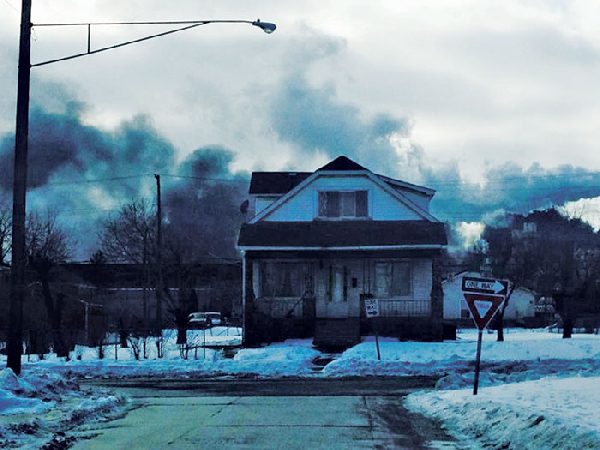
|
| Black smoke from the fire could be seen in Dearborn’s Southend neighborhoods. |
DEARBORN — Thick black smoke was spotted coming out of AK Steel’s Dearborn Works facility in the city’s Southend Monday, after a fire broke out.
In a statement released exclusively to The Arab American News, Barry Racey, a spokesman for AK Steel, said the company is still investigating the cause of the fire.
The fire started after a conveyer belt at the plant’s blast furnace caught fire. No injuries were reported.
Racey said there was no damage to the blast furnace itself. The blast furnace was temporarily shut down due to the conveyor belt damage. Repairs to the conveyor belt have been completed and the blast furnace has resumed operation. AK Steel purchased the facility from the former steel company Severstal last year.
The fire came only about two months after residents complained about an alleged air pollution violation occurring at AK Steel’s facility on Dec. 20 and almost a year after a controversial 2006 revised emissions permit was issued to Severstal that transferred over to AK Steel.
Rhonda Anderson, the senior organizing representative of the Sierra Club Detroit Chapter, and Dearborn resident Adel Mozip are concerned that the only pollutants tested at the air quality monitor located at Salina Elementary School on the day of the fire were PM 10 and PM 2.5.
Students walked home from school while the black smoke filled the air.
“Can you imagine having to attend school in a thick harmful smog such as this?” Dearborn Heights resident Rashid Baydoun posted on Facebook. “Well that is the reality elementary and middle school students face at one southeast Michigan school.”
Several people expressed outrage over the fire on social media.
“The MDEQ does have an air quality monitoring station at the Salina school,” Racey said. “It is our understanding that, during the time of the fire, the measure of fine particulate matter at the Salina school monitor was not elevated and was well within the standard. In addition, video of the incident indicates that the smoke from the fire was blowing in the opposite direction from the school.”
Because the air monitor only tested for fine particulate matter, there is no way of telling whether the area was impacted by other toxins.
Mozip went on the Michigan Department of Environemtnal Quality’s (MDEQ) website to check the air monitor while the fire was happening and said the results showed there was no unusual activity.
“Are the air monitors working out the way they should? I don’t know,” Mozip said.
Wilhelmina McLemore, the Detroit District supervisor for the MDEQ, confirmed that the only toxins scheduled to be tested that day at Salina Elementary School’s air monitor were PM 10 and PM 2.5.
While the former Severstal plant was an emitter of harmful sulfur dioxide emissions, the monitor at Salina Elementary School doesn’t test for sulfur dioxide emissions according to McLemore.
Anderson is concerned that no air testing was performed on the day of the incident, despite repeated calls that were made to the MDEQ and the EPA while the fire was taking place.
According to McLemore, the MDEQ doesn’t respond in the event of an emergency.
“We are not first responders,” she said.
Mohamed Ahmed, a resident of Dearborn’s Southend, said several residents in the area contacted the MDEQ regarding the fire, but never received a response. Mozip also said he contacted the environmental agency, but has not heard back.
“The plant is not required to, nor does it perform, ambient air quality monitoring,” Racey said. “That said, we understand that the Dearborn fire chief has indicated that the community was not impacted by the fire from an air quality standpoint.”
The company said the plant’s fourth quarter of 2014 environmental performance was likely the best in the history of the facility.
On Wednesday, March. 11, beginning at 6 p.m., a session on harmful Sulfur dioxide emissions in Wayne county will take place at the River Rouge City Hall. A discussion will also take place regarding the fire.






Leave a Reply